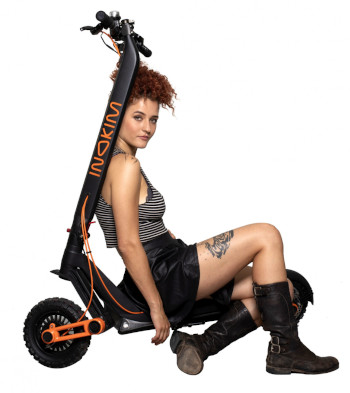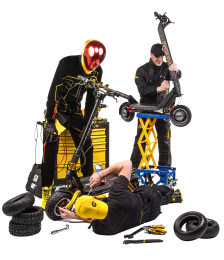Click for more results.
No produts were found.
Your cart is empty See the offer
 More and more customers are choosing their scooter based on the battery, namely based on its capacity. We've been observing this during phone calls, in emails received from customers and, very often, on social networks where there is a popular topic on who has a battery with a larger capacity. Bigger the capacity, the better. Lower the capacity, the worse. Right? However, this is not always so. If you are interested in why a battery with a smaller capacity may actually have more energy stored and provide a longer range as a result, continue reading so that next time you do not get fooled by an "expert" commenting on the Facebook.
More and more customers are choosing their scooter based on the battery, namely based on its capacity. We've been observing this during phone calls, in emails received from customers and, very often, on social networks where there is a popular topic on who has a battery with a larger capacity. Bigger the capacity, the better. Lower the capacity, the worse. Right? However, this is not always so. If you are interested in why a battery with a smaller capacity may actually have more energy stored and provide a longer range as a result, continue reading so that next time you do not get fooled by an "expert" commenting on the Facebook.
If you do not wish to read any further, the quick answer is that one needs to look at total energy stored, which is expressed in watt-hours (Wh). If you start looking for watt-hours, you can be sure that the battery you are buying has more energy stored in it when its specified watt-hour number is higher. Meaning, an electric scooter with 1536 Wh has more energy in the battery than the one with 504 Wh, simply because 1536 is more than 504. The comparison is linear. Where a battery has double the watt-hours, it also has twice as much energy in it. To put it simply, that battery is twice as "big".
Unfortunately, when it comes to batteries it is the capacity that is the most frequently mentioned and listed parameter (this bad practice being unfortunately used by some sellers of electric scooters), regardless of whether you are buying an ordinary power bank, headlamp, e-bike, e-scooter, laptop or an electric car. The battery capacity is indicated in Ah unit (ampere-hour), from which it is clear what "capacity" actually means. It defines what current (measured in Ampere unit) the battery is able to supply for how long (time unit, hour). This may again sound exactly what the buyer is looking for (i.e., how much energy is stored in the battery), yet despite its appearance, it is not the case at all. Therefore, if you rely on battery capacity when choosing a battery, you may end up with something completely different than you imagined.
The reason being that you are missing the essential information in your decision-making process, namely at what actual voltage the battery is able to supply the specified current for a given period of time. Only this truly corresponds to the total energy stored in the battery and the unit is the aforementioned Wh (watt-hour). It corresponds to the work performed by a machine with one watt power for a period of one hour, and also to 3 600 joules (since one joule corresponds to one watt-second). The Watt unit surely ringed a bell for you as it also used to specify the engine power. When it comes to batteries, the watt-hour means how much power your battery is able to supply for how long. And this is a wholly different number than the popular ampere-hour that only specifies the supplied current but says nothing at all about the power.
The relationship between power, current and voltage is simple – power is voltage multiplied by current. Therefore, if you know the battery's capacity and voltage, you can make the conversion to watt-hours by multiplying battery's voltage by its capacity to arrive to watt-hours.
 To make it easier for you to understand, imagine your battery as a pool. Its capacity being represented by the visible dimensions of the pool, i.e., length and width. But are these dimensions enough for you to know how much water is in fact in the pool? Surely not, because you also need to know how deep the pool is. And that is precisely what is represented by voltage, which is often forgotten when comparing battery sizes. It is clear that a pool half meter deep contains much less water in it than a pool of the same width and length that is two meters deep. And the same applies when it comes to battery sizes. Width and length are represented by amperes and hours and the depth is represented by voltage (Volts). The volume of water in the pool is then calculated as width times length times depth and the total energy stored in the battery is calculated as Amperes times hours times voltage = watt-hours.
To make it easier for you to understand, imagine your battery as a pool. Its capacity being represented by the visible dimensions of the pool, i.e., length and width. But are these dimensions enough for you to know how much water is in fact in the pool? Surely not, because you also need to know how deep the pool is. And that is precisely what is represented by voltage, which is often forgotten when comparing battery sizes. It is clear that a pool half meter deep contains much less water in it than a pool of the same width and length that is two meters deep. And the same applies when it comes to battery sizes. Width and length are represented by amperes and hours and the depth is represented by voltage (Volts). The volume of water in the pool is then calculated as width times length times depth and the total energy stored in the battery is calculated as Amperes times hours times voltage = watt-hours.
It is now clear why one needs to look not just at battery capacity but also at its voltage when choosing a scooter. Let's take VSETT 9+ Pro as an example. It offers a 21 Ah battery capacity, which is a decent number that equals what INOKIM OX S offers. So, seemingly, both scooters have the "same" battery. However, were you to buy a scooter while thinking so, you would get burnt since OX S offers 21 Ah at a voltage of 60 V and, therefore, it provides 1260 Wh of stored energy. The VSETT 9+ may offer the same 21 Ah, however at a voltage of 48 V and, therefore, it provides only 1008 Wh of stored energy. This comparison shows that INOKIM OX S has by up to 25% bigger battery than VSETT 9+ Pro, despite the fact that they have the same capacity.
 Things get even more interesting when we look at a 52 V version of the ZERO 10X model, which offers 23 Ah. At first glance, this is more than 21 Ah offered by INOKIM OX S. However, since we already know what to actually look for, we can easily conclude that at 23 Ah the ZERO 10X provides 1196 Wh while INOKIM OX S (thanks to its 60V battery) provides 1260 Wh of energy despite offering capacity of "only" 21 Ah. So, despite a smaller capacity (21 vs 23 Ah), the OX S actually has about 5% more stored energy than the 10X. This is a very nice, real-world example where a lower capacity actually means a "bigger" battery.
Things get even more interesting when we look at a 52 V version of the ZERO 10X model, which offers 23 Ah. At first glance, this is more than 21 Ah offered by INOKIM OX S. However, since we already know what to actually look for, we can easily conclude that at 23 Ah the ZERO 10X provides 1196 Wh while INOKIM OX S (thanks to its 60V battery) provides 1260 Wh of energy despite offering capacity of "only" 21 Ah. So, despite a smaller capacity (21 vs 23 Ah), the OX S actually has about 5% more stored energy than the 10X. This is a very nice, real-world example where a lower capacity actually means a "bigger" battery.
There is one more associated sales trick when it comes to power banks, which you will find easier to understand now. The manufacturers are very happy to state capacity in milliampere-hours, to have the number displayed as big as possible. Usually, they do not mention voltage at all, and this for good reason (for them). For instance, let's take a look at a popular power bank made by Xiaomi (Power Bank Pro 3, 20 000 mAh). The most important thing is to always state the biggest number possible, to make the product sell well. So, let's get rid of milliampere-hours first and covert them to more meaningful Ah. When we do so, we still get a nicely looking 20 Ah figure. I believe that nobody here continues to think that this power bank sold for a few euros has the same battery size as your 20 Ah electric scooter. Why don't you have a look at this power bank, for instance in your favorite electronics store. You probably won't see the voltage, at which this capacity is achieved. This is similar to buying a pool after agreeing on its width and length but forgetting to ask how deep you want the pool to be. In reality, this power bank has the stated capacity at the nominal voltage of the cells used in it, i.e., at 3.7 V, corresponding to a stored capacity of 74 Wh and, therefore, to only about 5% of the energy present in INOKIM OX S (to name one scooter model), and this despite the fact that they both claim almost identical capacity (21 vs 20 Ah). Still, the tricks used by manufacturers do not end here as the output voltage of a power bank differs from the nominal voltage of the used battery cells. The USB operates at 5V. So, if only the manufacturers wanted to play a fair game, they should be stating capacities at this output voltage. After conversion, the capacity of this particular power bank is about 14.8 Ah, which means 14 800 mAh (and not 20 000 as they indicate on the packaging). However, since only a few people understand this, more power banks are sold by manufacturers who discover ways how to specify a higher number. That is why the manufacturers of scooters with low-voltage battery proudly announce its capacity while making it difficult to find the voltage or stored energy expressed in Wh.
Over the next few days, we will contact you to fine-tune the details.
Over the next few days, we will contact you to fine-tune the details.
We work hard to provide you with the best experience possible.
Over the next few days, we will contact you to fine-tune the details.
We're sorry you don't have enough information about your order. We always try to continuously inform our customers about everything. Please fill in the information below and we shall get back to you as soon as possible, after checking the situation.
We are grateful for all positive feedback and recommendations. It motivates us in our everyday work.
We are sorry that something is wrong. Please provide the most accurate description of your situation so that we may check and resolve it promptly. Your complaint will be received not only by our employees but also by the management and owners of Max Blinker company.
Thank you for your message. We will get back to you as soon as possible.
Help us to improve. Do you have any suggestions?
Every nice word we hear from you will make us happy. Contact us.
Did you find any error in the text? We shall appreciate if you let us know.
Thank you for your message. We will get back to you as soon as possible.
 Professional service service@maxblinker.com +49 304 2208 222 Order a service Warranty online More info about the service
Professional service service@maxblinker.com +49 304 2208 222 Order a service Warranty online More info about the service  Escooter Guide Read our extensive guide on how to safely ride your electric scooter. It is full of information of interest to both beginners and advanced riders. Read the Guide
Escooter Guide Read our extensive guide on how to safely ride your electric scooter. It is full of information of interest to both beginners and advanced riders. Read the Guide  Independent Testing We scientifically verify manufacturers’ claims about range, performance and top speed. More info
Independent Testing We scientifically verify manufacturers’ claims about range, performance and top speed. More info Voltride meníme na Max Blinker
More info